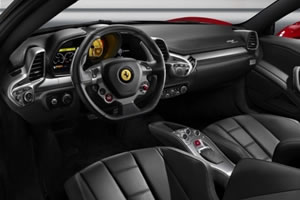Ferrari 458 Italia's interior in detail
31 Aug 2009|6,755 views
 |
The car's interior, steering wheel and instrument binnacle also represent a significant step forward in the concept of the ergonomic interface between driver and car.
The main controls are located on the steering wheel, while secondary commands are set in two satellite pods either side of the dashboard, and the instrument panels in front of the driver are now more comprehensive, enhancing the safety aspect by enabling the driver to concentrate fully on driving.
All steering-column mounted stalks have been eliminated, with the indicators, full beam, flash and windscreen wiper functions now being activated by buttons on the steering wheel boss. The button to select the shock absorber setting is now positioned next to the 'Engine start' button where it falls readily to hand. Behind the wheel are a number of secondary functions, such as the stereo, while the gearbox paddles are now longer, making shifts even easier from any steering angle.
The right-hand satellite pod on the dash incorporates controls for the infotainment, Bluetooth connectivity, satellite-navigation, the digital speedometer and rear parking camera. Clustered on the left-hand satellite pod are the optional cruise control, buttons for choosing the video setting of the left-hand dash TFT screen and the on-board computer interface. The latter controls the trip computer, the Vehicle Dynamic Assistance (VDA) and the display of the car's set-up.
The VDA monitors the operating parameters of the most important areas of the car--engine/gearbox, tires and brakes. The VDA is enabled in the following manettino settings, Race, CT off and CST off, and provides visual confirmation of the status of each component based on an algorithm from parameters reading lateral and longitudinal acceleration, revs and speed. This enables the driver to assess the ideal operating conditions for the car. There are three status settings: Warm-up (operating temperature too low), Go (ideal operating conditions) and Over (one or more components are no longer at their optimum level and need cooling).
 |
The car's interior, steering wheel and instrument binnacle also represent a significant step forward in the concept of the ergonomic interface between driver and car.
The main controls are located on the steering wheel, while secondary commands are set in two satellite pods either side of the dashboard, and the instrument panels in front of the driver are now more comprehensive, enhancing the safety aspect by enabling the driver to concentrate fully on driving.
All steering-column mounted stalks have been eliminated, with the indicators, full beam, flash and windscreen wiper functions now being activated by buttons on the steering wheel boss. The button to select the shock absorber setting is now positioned next to the 'Engine start' button where it falls readily to hand. Behind the wheel are a number of secondary functions, such as the stereo, while the gearbox paddles are now longer, making shifts even easier from any steering angle.
The right-hand satellite pod on the dash incorporates controls for the infotainment, Bluetooth connectivity, satellite-navigation, the digital speedometer and rear parking camera. Clustered on the left-hand satellite pod are the optional cruise control, buttons for choosing the video setting of the left-hand dash TFT screen and the on-board computer interface. The latter controls the trip computer, the Vehicle Dynamic Assistance (VDA) and the display of the car's set-up.
The VDA monitors the operating parameters of the most important areas of the car--engine/gearbox, tires and brakes. The VDA is enabled in the following manettino settings, Race, CT off and CST off, and provides visual confirmation of the status of each component based on an algorithm from parameters reading lateral and longitudinal acceleration, revs and speed. This enables the driver to assess the ideal operating conditions for the car. There are three status settings: Warm-up (operating temperature too low), Go (ideal operating conditions) and Over (one or more components are no longer at their optimum level and need cooling).
Latest COE Prices
April 2025 | 1st BIDDING
NEXT TENDER: 23 Apr 2025
CAT A$97,724
CAT B$117,899
CAT C$68,782
CAT E$117,002
View Full Results Thank You For Your Subscription.




















